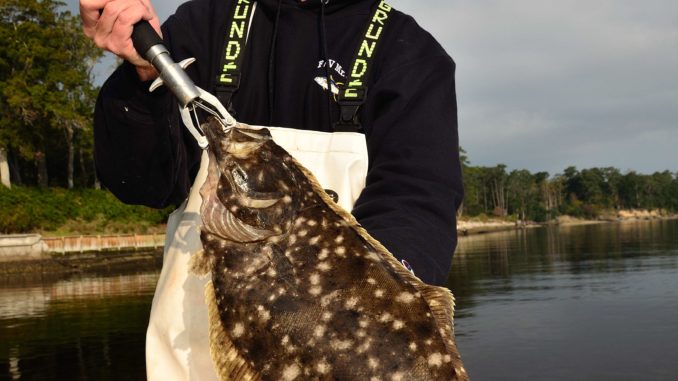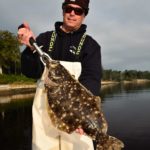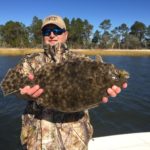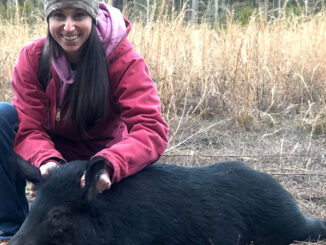
Interrupt the migration of flatfish toward the ocean this month with the right bait or lure, and you can count on tasty fillets to go along with that Thanksgiving turkey.
Fall fishing is in full swing along the Carolina coast, and although many anglers think about king mackerel, speckled trout and spots, flounder fishing can be fantastic; it’s the time when many of the biggest specimens make it into the boat.
It’s hard to beat the area around the North Carolina/South Carolina border, with its numerous inlets, creeks and other structure-filled waters along the Atlantic Intracoastal Waterway are ideal places to find doormat flounder when bait is thick and the weather is ideal.
Through the summer, flounder are at the top of the list for inshore fishery options, but they are often overlooked in the fall when speckled trout start to show up in massive schools. Tom Cushman of Captain Cush’s Calmwater Charters in Myrtle Beach, S.C., said flounder are still plentiful and a solid option for his anglers.
“Our numbers drop some, but the size increases,” Cushman said. “The big ones will stay around and fatten up before they head into the ocean for the winter.”
In November, the estuaries are generally still packed with bait, including of mullet and shrimp, depending on the water temperature. At some point, these bait caches will leave when water temperatures fall towards winter levels, but until they do, inshore predators, including fat, doormat flounder, will be around to take advantage of the easy meals.
Fall fishing is dependent on water temperature, but a major change doesn’t happen overnight. Thermal cooling takes a while, since many fall days will have 30- to 40-degree temperature swings. However, fish will migrate locally after several days of chilly weather, mostly to find a better ambush spot. If anglers find where the bait is headed, they can find the predators, including big, fat flounder.
Anglers targeting flounder are in luck, because the section of the ICW between Southport, N.C., and Myrtle Beach, S.C., is full of freshwater inputs, deep water and virtually unlimited structure. While some baitfish will move into the ocean during a fall cold spell, the majority will head inland towards brackish waters to find deep holes and warmer water.
Cushman said structure is critical for big, fall flounder in the Little River, S.C., area.
“Big flounder are structure-related, and the waterway is the best spot locally,” he said. “I like the docks and the rocky ledges along the edge of the channel.”
This section of the ICW is unique because of the major freshwater input coming from the Waccamaw River to the south and because the waterway narrows significantly at the freshwater/saltwater dividing line, causing an increase in the current that predator fish take advantage of when baitfish get swept along. And the high number of docks and other flooded structure provides adequate habitat for flounder.
Cushman likes to fish tight to the structure and next to the channel drop-off.
“Flounder will hold tight to structure,” he said. “I do the best when I can pitch the baits within 8 inches of the structure. The closer you can get to the structure, the more bites you will get.”
But the ICW isn’t the only place to find big flounder, either.Greer Hughes of Cool Runnings Guide Service in Oak Island, N.C., fishes the North Carolina side from Ocean Isle Beach to Southport. He catches flounder during the fall around main creek mouths leading to the ocean.
“Flounder go offshore when it gets real cold, but before they take off, they will tighten up to the bottom in the creeks near the main runs along structure,” Hughes said. “The bait piles up at the top of the creeks close to structure.”
Hughes is a huge fan of places filled with structure, and the waters stretching from Bald Head Island to the state line are not without plenty of tackle-snagging objects. From the shipping dockages along the Cape Fear River to the creeks off the ICW near the Shallotte and Lockwood Folly rivers offer endless opportunities to find flounder preying on jumbo schools of mullet in the fall.
“The bait will pile up along the creek points with oysters, along grass edges, docks and in any place where the structure concentrates the mullet this time of year,” he said.
As the current brings water in and out of the estuaries, flounder maneuver to get the best seat at the dinner table. Hughes’ favorite tides to fish are quite different than what most fishermen prefer.
“I like the top of the rising tide. The last two hours leading up to the high tide are my favorite because it pushes the bait up next to the grass line and along oyster shells,” he said.
On the tail end of the rise, the water is typically the clearest it will be, and since flounder feed by sight, it opens up more opportunities. Typically, the water is significantly clearer in the fall, and that makes it even better for flounder looking to fill up on mullet before the winter season arrives.
The low tide creates a scenario that cannot be ignored either. Cushman prefers the low end of the tide for fall flounder.
“Low water concentrates the bait and the flounder along the available, flooded structure,” he said. “In the waterway, most of the docks will be dry, and the fish will be tight around the end of the docks in the deep holes up against the pilings.”
In both situations, baitfish will make every attempt to avoid becoming eaten, running in shallow water when they can and huddling up in deep pockets when the water temperature falls. But flounder are built to hide at any depth, from 20 feet to just a few inches.
“They can be in 10 inches of water or along the bottom in a deep hole, and in the fall conditions, the flounder will move around in both of these places,” he said.
When the water cools, flounder can seek refuge in deep holes, but they will come up to the shallow edges when the sun is out to take advantage of solar heating. Anglers need to fish both shallow and deep spots throughout the tide.
DESTINATION INFORMATION
HOW TO GET THERE — The waters along the North Carolina/South Carolina State line are easily accessed from several public boat ramps off the ICW. In North Carolina, the public boat ramps under the causeway bridges at Sunset Beach, Holden Beach, and Ocean Isle Beach offer easy access to the lower Brunswick County waters. In South Carolina, the two public boat ramps under the US 17 Bridge in the Intracoastal Waterway in Cherry Grove/North Myrtle Beach are the best ways to access the Little River estuary. Lists of all boating facilities are available at www.dnr.sc.gov/pubs/boatfacilities.pdf and www.ncwildlife.org/Boating_Waterways.
WHEN TO GO — Flounder fishing is great in November and cast last into December, if inshore water temperatures remain in the 60s. Fish will move to the ocean or to deeper areas inshore when they fall into the 50s.
BEST TECHNIQUES — Spinning or baitcasting gear are both good choices with 20- to 30-pound braid; go with 7-foot rods in medium to medium-heavy actions. Mullet are the most-common forage in estuaries in November and are the best live baits, but shrimp are productive if they’re still around. Fish tight to structure with a Carolina rig, drop-shot rig or a jighead. Soft-plastic artificials are also good choices. Bright colors such as whites and chartreuses are preferred because most flounder bites are reaction strikes.
FISHING INFO/GUIDES — Tom Cushman, Captain Cush’s Calmwater Fishing Charters, 843-997-5850, www.captaincush.com; Greer Hughes, Cool Runnings Charters, 910-523-0312, www.coolrunningscharters.com. See also Guides and Charters in Classifieds.
ACCOMMODATIONS — Causeway Inn, Ocean Isle Beach, 910-579-0743; Hampton Inn-North Myrtle Beach Harbourgate, 843-249-1997; Myrtle Beach Area Convention and Visitors Bureau, www.mbchamber.com; Brunswick County Vacation Guide, 910-755-5517, www.ncbrunswick.com).
MAPS — Navionics, www.navionics.com, 800-848-5896; The Good Spots, 1-800-411-0185, www.thegoodspots.com ; Grease Charts www.greasechart.com (AC 002-A: Long Bay-Cape Fear).







Be the first to comment